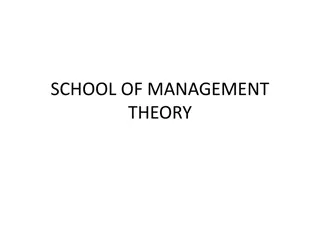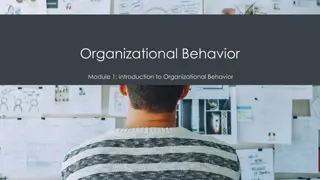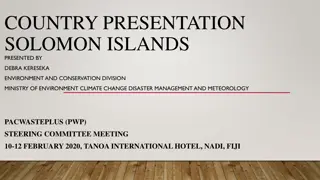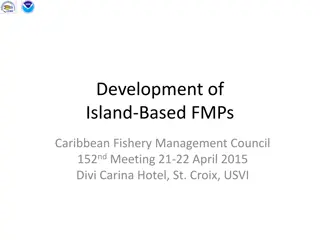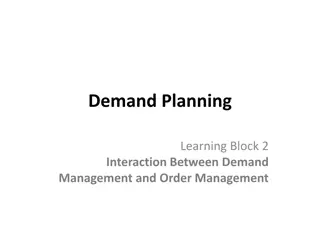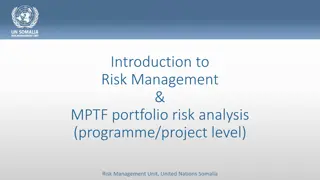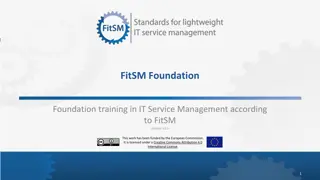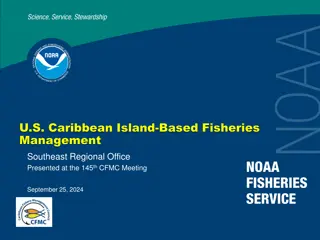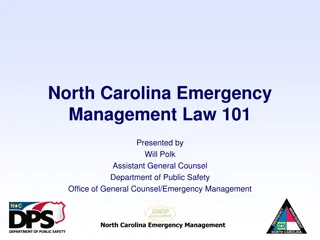
Understanding the Fundamentals of Management
Explore the essence of management, including its nature, roles, and processes. Learn about efficiency, effectiveness, managerial functions, and the multifaceted responsibilities of managers as outlined by Henry Mintzberg. Delve into the various roles managers play in interpersonal, informational, and decisional capacities within organizations.
Download Presentation

Please find below an Image/Link to download the presentation.
The content on the website is provided AS IS for your information and personal use only. It may not be sold, licensed, or shared on other websites without obtaining consent from the author. If you encounter any issues during the download, it is possible that the publisher has removed the file from their server.
You are allowed to download the files provided on this website for personal or commercial use, subject to the condition that they are used lawfully. All files are the property of their respective owners.
The content on the website is provided AS IS for your information and personal use only. It may not be sold, licensed, or shared on other websites without obtaining consent from the author.
E N D
Presentation Transcript
NATURE OF MANAGEMENT Efficiency Getting work done through others Effectiveness Efficiency is getting work done with a minimum of expense, or waste. Effectiveness is accomplishing tasks that help full organizational objectives, such as customer service and satisfaction. 1
Who is a Manager? A manager is a person responsible for the work performance of group members. What is management? The process of using organizational resources to achieve organizational objectives through planning, organizing, controlling. leading, and
The extent to which managers perform the functions of management - planning, organizing, leading, and controlling - varies by level in the management hierarchy. DECIDE DIRECT DEAL DO
Managers wear many hats as they carry out the four management functions. Henry Mintzberg, management professor from Canada s McGill University, identifies three major roles that managers perform as they carry out the work of management: Interpersonal Informational Decisional
Management Roles: 1.Interpersonal Roles: Role Description Identifiable Activities Figurehead The symbolic head who is required to perform a number of routine social or legal duties Ceremony, solicitations Leader Responsible for motivating and activating subordinates as well as for staffing, training and associated duties Virtually all managerial activities involving subordinates Liaison Managers develop and cultivate relationships with individuals and groups outside their area of direct responsibility. A supervisor, for e.g., may develop a network with other supervisors
2.Informational Roles: Role Description Identifiable Activities Seeks and receives wide variety of information to develop a thorough understanding of the organization so as to be the centre of internal and external information. Disseminator Transmits information received from outsiders and subordinates to organization members. Receiving (including periodical news and observational tours). information Monitor Forwarding information into organization (e-mail, letters, face-to-face). Spokesperson Transmits information about to Board meetings, transmission of information to outsiders. outsiders plans, policies, actions and results and serves as an expert. organization
3.Decisional Roles: Role Description Identifiable Activities Entrepreneur Searches internally for and Strategy and review sessions involving initiation or design of improvement projects. externally initiates improvement projects. opportunities, Disturbance Handler Responsible for corrective action when the organization faces important, unexpected disturbances. Strategy and review sessions involving disturbances and crises. Resource Allocation Responsible for the allocation of resources thereby making or approving all significant decisions. Scheduling, requesting authorization, budget activities, and programming subordinates' work. Responsible for representing the organization at major negotiations. Negotiation Negotiator
Managerial Roles currently emphasized Managers today emphasize horizontal relationships and de-emphasize vertical (top-down) relationships. OLD MANAGER Thinks of self as boss. NEW MANAGER Thinks of self as team leader or internal consultant. Deals with anyone necessary to get the job done. Invites others to join in decision making. Demands results. Follows the chain or command. Makes most decisions alone. Demands long hours of working.
Management Skills: In order to perform the functions of management and to assume multiple roles, managers must be skilled. Robert Katz identified three managerial skills that are essential to successful management: technical, human, and conceptual. A manager's level in the organization determines the relative importance of possessing technical, human, and conceptual skills.
oTechnical Skills involves process or technique knowledge and proficiency. Managers use the processes, techniques and tools of a specific area. oHuman skillinvolves the ability to interact effectively with people. Managers interact and cooperate with employees. oConceptual skill involves the formulation of ideas. Managers understand abstract relationships, develop ideas, and solve problems creatively. Thus, technical skill deals with things, human skill concerns people, and conceptual skill has to do with ideas.
THE IMPORTANCE OF THEORY AND HISTORY Why Theory? Provides a conceptual framework for organizing knowledge and providing a blueprint for action. Most managers develop their own theories about how they should run their organizations. Why History? An awareness and understanding developments in management are important. Furthers the development of management practices. Avoiding the mistakes of others in the past. of historical
CLASSICAL MANAGEMENT PERSPECTIVE Scientific Management Concerned with improving the performance of individual workers (i.e., efficiency). Grew out of the industrial revolution s labor shortage at the beginning of the twentieth century. Administrative Management A theory that managing the rather than individuals. focuses on total organization
SCIENTIFIC MANAGEMENT Frederick Taylor Replaced old methods of how to do work with scientifically-based work methods. Eliminated soldiering, where employees deliberately worked at a pace slower than their capabilities. Believed in selecting, training, teaching, and developing workers. Used time studies of jobs, and piece-work pay systems to control and motivate employees.
SCIENTIFIC MANAGEMENT PIONEERS Frank and Lillian Gilbreth Both developed techniques and strategies for eliminating inefficiency. Frank reduced the number of movements in bricklaying. Lillian made substantive contributions to the fields of psychology and personnel management.
HENRY GANTT: Gantt devised an incentive system that gave workers a bonus for competing their jobs in less time than the allowed standard. Introduced charts to see how plans were progressing and to take the necessary action to keep projects on time. gantt charts
Administrative Management Theory Focuses on managing the whole organization rather than individuals. Henri Fayol Was first to identify the specific management functions of planning, organizing, leading, and controlling. Max Weber His theory of bureaucracy is based on a rational set of guidelines for structuringorganizations.
Fayol laid down the following principles of organization: Specialization of labor. continuous improvement in skills and the development of improvements in methods. Authority. The right to give orders and the power to exact obedience. Discipline. No slacking, bending of rules. Unity of command. Each employee has one and only one boss. Unity of direction. A single mind generates a single plan and all play their part in that plan. Subordination of Individual Interests. When at work, only work things should be pursued or thought about. Remuneration. Employees receive fair payment for services, not what the company can get away with. Specializing encourages
Centralization. Consolidation of management functions. Decisions are made from the top. Scalar Chain (line of authority). Formal chain of command running from top to bottom of the organization Order. All materials and personnel have a prescribed place, and they must remain there. Equity. Equality of treatment (but not necessarily identical treatment) Personnel Tenure. Limited turnover of personnel. Lifetime employment for good workers. Initiative. Thinking out a plan and do what it takes to make it happen. Esprit de corps. Harmony, cohesion among personnel.
Behavioural Studies THE HAWTHORNE STUDIES Conducted by Elton Mayo and associates at Western Electric Purpose of study was to examine what effect monotony and fatigue had on productivity and how to control them with variables such as rest breaks, work hours, illumination.
Illumination Study Designed to test the effect of lighting intensity on worker productivity The mere practice of observing people s behaviour tends to alter their behaviour (Hawthorne Effect) Taken together, all studies helped to document the powerful nature of social relations in the workplace and moved managers more toward the interpersonal aspects.
BEHAVIORAL MANAGEMENT PERSPECTIVE (CONT D) Human Relations Movement Grew out of the Hawthorne studies. Proposed that workers respond primarily to the social context of work. Assumed that the manager s concern for workers would lead to increased worker satisfaction and improved worker performance.
BEHAVIORAL MANAGEMENT PERSPECTIVE (CONT D) Abraham Maslow Advanced a theory that employees are motivated by a hierarchy of needs that they seek to satisfy. Douglas McGregor Proposed Theory X and Theory Y concepts of managerial beliefs about people and work.
THEORY X AND THEORY Y Theory X Assumptions -People do not like work and try to avoid it. -People do not like work, so managers have to control, direct, and threaten employees to get them to work toward organizational goals. -People prefer to be directed, to avoid responsibility Theory Y Assumptions -People do not dislike work; work is a natural part of their lives. -People are committed to goals to the degree that they receive rewards when they reach their objectives. -People both seek and accept responsibility under favorable conditions.
ORGANIZATIONAL BEHAVIOUR A contemporary field focusing on behavioral perspectives on management. Draws on psychology, sociology, etc. Important topics in organizational behavior research: Job satisfaction and job stress Motivation and leadership Group dynamics and organizational politics Interpersonal conflict The structure and design of organizations
QUANTITATIVE APPROACH TO MANAGEMENT Quantitative Approach Also called operations research or management science Evolved from mathematical and statistical methods developed to solve WWII military logistics and quality control problems Focuses on improving managerial decision making by applying: Statistics, optimization models, etc
SYSTEMS APPROACH A system is defined as a set of interrelated or interacting elements. Open System continually interacts with its environment Closed System has little interaction with its environment; it receives very little feedback from the outside
Organizations are open systems that Organizations are open systems that constantly interact with the external constantly interact with the external environment: environment: Inputs Inputs Outputs Outputs The people, money, information, equipment, and materials required to produce organization s goods or services The products, services, profits, losses, employee satisfaction or discontent, and the like that are produced by the organization Feedback Feedback Transformational Processes Transformational Processes The organization s capabilities in management and technology that are applied to converting inputs to outputs Information about the reaction of the environment to the outputs that affect the inputs
IMPLICATIONS OF THE SYSTEMS APPROACH Coordination of the organization s parts is essential for proper functioning of the entire organization. Decisions and actions taken in one area of the organization will have an effect in other areas of the organization. Organizations are not self-contained and, therefore, must adapt to changes in their external environment.
Contingency Approach Also sometimes called the situational approach. There is no one universally applicable set of management principles by which to manage organizations. Organizations are individually different, face different situations (contingency variables), and require different ways of managing.






